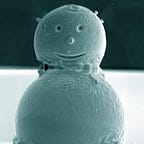The Secret, staring at you: Valentin Turchin
I have known for years that I should read “The Phenomenon of Science,” by Valentin Turchin, but I have done so only recently. The book ends with a reflection on the possibility of resurrection.
Ben Goertzel opens “A Cosmist Manifesto” with a dedication to Valentin Turchin, “a great Soviet-American scientist and futurist visionary” who died the year the book was completed. Ben considers Turchin’s book “The Phenomenon of Science” as “one of the most elegant statements of Cosmist scientific philosophy ever written.” A free version of Turchin’s book is available online in the “Principia Cybernetica” website.
Turchin concludes “The Phenomenon of Science” with a reflection on the possibility of resurrection:
“We shall hope that we have not yet made an uncorrectable mistake and that people will be able to create new, fantastic (from our present point of view) forms of organization of matter, and forms of consciousness. And then the last, but also the most disturbing, question arises: can’t there exist a connection between the present individual consciousness of each human personality and this future superconsciousness, a bridge built across time? In other words, isn’t a resurrection of the individual personality in some form possible all the same?
Unfortunately, all we know at the present time compels us to answer in the negative. We do not see any possibility of this. Neither is there a necessity for it in the process of cosmic evolution. Like the apes from which they originated, people are not worth resurrection. All that remains after us is what we have created during the time allotted to us.
But no one can force a person to give up hope. In this case there is some reason to hope, because our last question concerns things about which we know very little. We understand some things about the chemical and physical processes related to life and we also can make our way in questions related to feelings, representations, and knowledge of reality. But the consciousness and the will are a riddle to us. We do not know the connection here between two aspects: the subjective, inner aspect and the objective, external aspect with which science deals. We do not even know how to ask the questions whose answers must be sought. Everything here is unclear and mysterious: great surprises are possible.
We have constructed a beautiful and majestic edifice of science. Its fine-laced linguistic constructions soar high into the sky. But direct your gaze to the space between the pillars, arches, and floors, beyond them, off into the void. Look more carefully, and there in the distance, in the black depth, you will see someone’s green eyes staring. It is the Secret, looking at you.”
Turchin’s words are sober, but leave the door open to hope. Nobody can force you to give up hope. On the contrary, science offers reasons to hope that the Secret in the black depth might permit the continuation of personal consciousness after physical death.
I don’t need certainty: For me, hope is good enough, especially the kind of hope that relies on action. I am persuaded that some forms of resurrection of the individual personality are possible in the physical universe, and I hope that future scientists will develop the science and practical engineering of technological resurrection. This is not, or not only, wishful thinking, but a project.
In recent writings I have outlined some aspects of contemporary science that seem to offer reasons to hope. Most (probably all) of my suggestions are likely to be wrong, or hopelessly naive. But so what? In a cosmist spirit, I believe that “science in its current form, just like religion and philosophy in their current forms, may turn out to be overly limited” for understanding these things. Future thinkers (perhaps you, or your grandchildren?) will do much better.
Picture from Wikimedia Commons.
